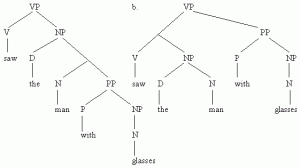Ambiguity means that an expression has more than one meaning. These ambiguities usually disappear in context.
Lexical ambiguity
Lexical ambiguity is straightforward. An easy example is the word glasses, which may mean things you drink from or things you look through.


If you think about actual situations in which you might use the word glasses, it is usually clear which meaning you intend. How about a sentence like the following?
1. She is a French teacher.
In this case, is she a teacher of the French language, or a teacher (of mathematics or geography etc.) who comes from France? Does French mean of the French language or from France?

Can you think of a situation in which this kind of thing might really be confusing?
Structural ambiguity
Structural ambiguity occurs when the syntactic (grammatical) structure of an expression influences the meaning. Take an example like this:
2. I saw the man with glasses.

3. She killed the man with the tie.
What meanings can sentence 3 have? What does the grammatical structure below indicate?

How about the following noun phrase?
4. Porcelain egg container.
Is it an egg container made of porcelain?

Or is it a container for porcelain eggs?

How would you show the ambiguity in the grammar?

Referential ambiguity
Referential ambiguity occurs when words refer to someone or something, but the reference is not specific.
5. Ken loves his girlfriend.
In 5, the noun phrase his girlfriend could mean Ken’s own girlfriend or somebody else’s girlfriend. Would this kind of thing be confusing in context?
Scope ambiguity
6. Three students shot four professors.
What does sentence 6 mean? Does it mean that there are four students who each shot three professors (a total of twelve professors)? Or does it mean that a gang of students shot four professors altogether (so a total of only four dead professors)?
Also, how about sentence 7?
7. Every boy likes a girl.
This could mean that each boy likes a different girl. So if there are three boys, there might be three girls altogether who they like. Or it could mean that they all like the same girl. Remember Predicate Logic? Is the following formula in 8 enough to take care of the ambiguity in 7?
8. ∀x ∃y(Boy (x) → (Girl (y) & Like (x, y)))
A lot of linguists have said it is not enough, but what do you think? Is there anything preventing y being the same individual in 8?
Pragmatic ambiguity
Pragmatic ambiguity probably isn’t really ambiguity at all. It merely shows how our interpretations of statements always vary depending on the situation or context.
Look at sentence 9.
9. Do you have life insurance?
9. could be a straightforward question. It could also be an offer. It could also be a threat. Can you think of situations in which these interpretations might arise?